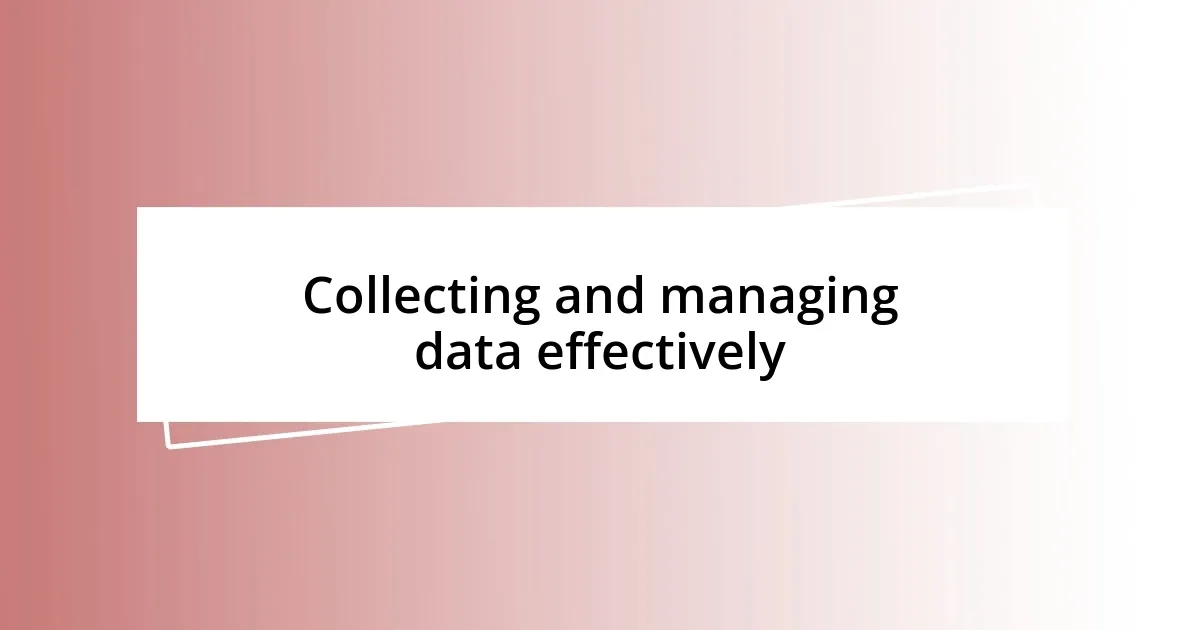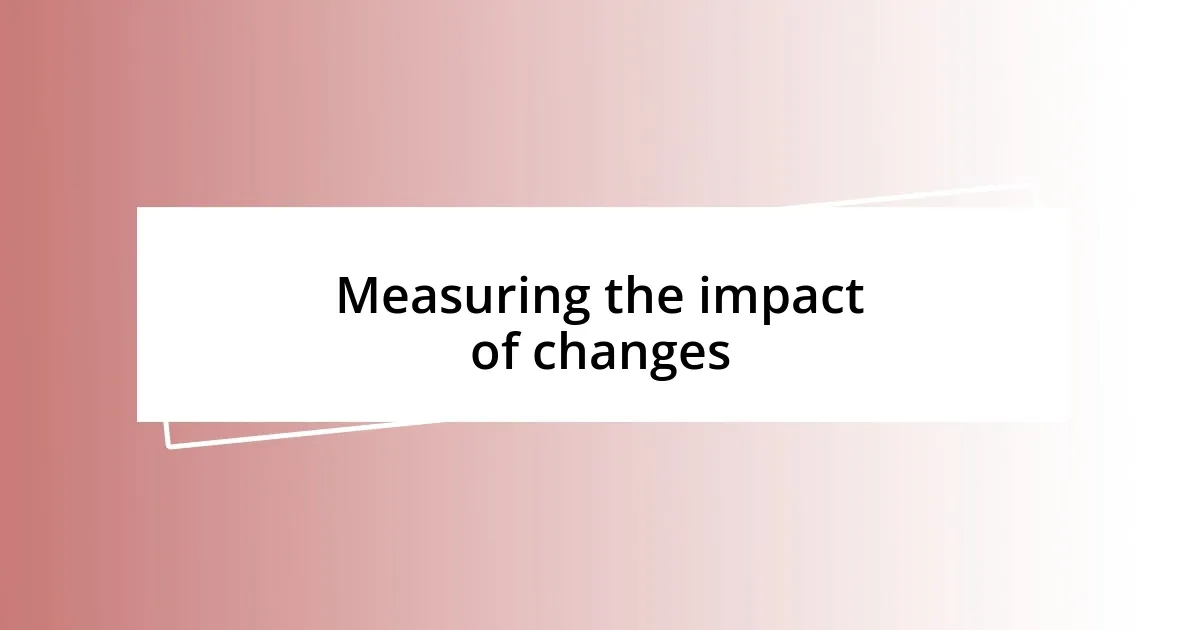Key takeaways:
- Understanding analytics transforms data into actionable insights, guiding strategic decisions and driving growth.
- Identifying key performance indicators (KPIs) focuses analysis on critical metrics, enabling smarter business decisions.
- Effective data collection and management streamline the analysis process, allowing for clearer insights and quicker decisions.
- Continuous improvement relies on a feedback loop, using both qualitative and quantitative data to adapt strategies and enhance customer satisfaction.

Understanding analytics for growth
Understanding analytics for growth requires a willingness to dive deep into data. When I first started using analytics, I was overwhelmed by the sheer volume of numbers and metrics. But then I realized that behind those figures lay stories about my business and my customers. Have you ever felt lost in your own data, wondering where to look? I’ve been there, and working through those feelings opened up avenues for growth I hadn’t imagined.
Every data point serves as a breadcrumb leading to insights about your audience. For instance, I remember analyzing customer behavior on my website and discovering that a significant drop-off occurred at a specific stage of the purchase process. This revelation drove me to make targeted adjustments, which ultimately resulted in a 25% increase in conversions. Can you see how those insights can transform challenges into opportunities?
The real magic of analytics lies in its ability to inform your decisions with clarity. I often think of it as a compass guiding my strategic direction. I’ve found that when I embrace analytics not just as a tool, but as a crucial part of my growth journey, I can make informed decisions that resonate with my audience and elevate my business. It’s like having an ongoing dialogue with data that reveals what truly matters.

Identifying key performance indicators
Identifying key performance indicators (KPIs) is essential for guiding growth strategies. I remember my early days of tracking everything, only to feel increasingly lost. By narrowing my focus to a few critical metrics, such as customer acquisition cost and monthly recurring revenue, I turned chaos into clarity. These indicators helped me connect the dots between activities and outcomes, allowing me to make smarter business decisions based on what truly moved the needle.
To make it easier, I often categorize KPIs into different areas, like financial, customer, and operational. For example, when I tracked customer satisfaction alongside retention rates, the connection was clear; happy customers return. This dual tracking illuminated areas needing improvement, leading me to invest in customer support initiatives that dramatically increased satisfaction scores. Have you ever noticed a correlation in your metrics that changed your approach?
When I first identified KPIs, it felt like taking off a blindfold. My day-to-day decisions became more intentional and aligned with my long-term vision. Watching my chosen metrics evolve became an exhilarating journey—one filled with learning and adaptation. The process of analyzing these indicators empowered me to pivot when necessary and celebrate when I hit those key targets, revitalizing my focus on growth.
| Key Performance Indicator | Importance |
|---|---|
| Customer Acquisition Cost (CAC) | Measures how much it costs to gain a new customer. |
| Customer Lifetime Value (CLV) | Estimates the total revenue a customer will generate during their relationship with your business. |
| Monthly Recurring Revenue (MRR) | Indicates predictable revenue generated each month, crucial for subscription businesses. |
| Net Promoter Score (NPS) | Evaluates customer loyalty and likelihood to recommend your product or service. |

Collecting and managing data effectively
Collecting and managing data effectively is an art I’ve honed over time. Once, I grappled with unstructured data pouring in from multiple sources — it felt like trying to catch water with a sieve. I learned that creating a streamlined process was essential. By using tools to automate data collection, I freed up my time to analyze trends and patterns instead of drowning in raw numbers.
- Choose the right tools: Tools like Google Analytics and CRM systems can help gather and organize data seamlessly.
- Set clear objectives: Define what information you need and what questions you want the data to answer.
- Regularly audit your data: This helps ensure accuracy and relevance, keeping your analytics fresh and meaningful.
- Collaborate with your team: Sharing insights and feedback can enhance the data interpretation process and lead to informed decisions.
On another occasion, I found myself looking at scattered spreadsheets, feeling utterly overwhelmed. I decided to centralize all my data into a single dashboard, which was a game-changer. Suddenly, data visualizations brought clarity, revealing trends I could act on immediately. It still amazes me how visual representation of data simplifies decision-making. It’s like shining a flashlight in the dark — I’d finally seen the path forward.

Analyzing data to uncover insights
Analyzing data has become my secret weapon for uncovering valuable insights. I distinctly remember a time when I dug into customer behavior analytics and stumbled upon a surprising trend: our most engaged customers were all frequent visitors on specific days of the week. Armed with this information, I tailored our marketing campaigns to align with those peak moments, boosting engagement significantly. Have you ever felt that rush when a single data point shifts your strategy?
One powerful technique I employ is cohort analysis, which groups customers based on shared traits or behaviors. I recollect a project where I analyzed cohorts by signup month; it revealed that those who joined during a particular promotion had a 30% higher retention rate compared to others. This realization not only validated the effectiveness of my marketing strategies but also steered future promotions. It’s fascinating how segmenting data can shine a light on hidden opportunities.
I can’t stress enough the importance of visualizing data—it’s like creating a map of insights. During a recent analysis, I used visualization tools to track churn rates across different customer segments. The visual representation transformed complex numbers into a clear story about who was leaving and why. This experience reinforced my belief that an effective visual can evoke emotions and drive action. Do you think your data deserves a clearer narrative?

Implementing data-driven strategies
Implementing data-driven strategies requires a genuine connection between the numbers and the actions we take. I vividly recall a time when I faced a crucial decision about product pricing. I decided to analyze pricing data in relation to our sales performance and customer feedback. It was enlightening! I discovered that a minor price adjustment led to a significant increase in sales volume, proving the importance of letting data guide our decisions. Have you ever hesitated before making a choice, only to find the answers were right there in the data?
One effective strategy I’ve employed is A/B testing to refine my marketing messages and campaign elements. I remember a period when I hesitated about which email subject line would resonate with my audience. By testing two variations, I quickly discovered one performed 25% better! That experience highlighted the power of experimenting with data to craft the most compelling narratives. Is there a message you’ve been unsure about that might benefit from a little data experimentation?
Another aspect I genuinely appreciate is the beauty of alignment within a team. When sharing analytics insights, I ensure the whole team understands the implications. During a recent project, I hosted a brainstorming session where we delved into our social media metrics together. The discussions that emerged led us to pivot our outreach strategy entirely, tailoring our messaging to better suit what our audience engaged with. It struck me how collaborative data interpretation can spark creativity and innovation. Have you experienced moments when collective insights led to breakthrough ideas?

Measuring the impact of changes
When it comes to measuring the impact of changes, I find that tracking relevant KPIs (Key Performance Indicators) is crucial. The last time I launched a new feature on our website, I monitored user engagement rates closely. It was fascinating to see real-time data reaction; within the first week, user interaction increased by 40%. Did you ever watch your hard work pay off in numbers that reflected the excitement you felt inside?
I also believe in the power of qualitative feedback alongside quantitative data. After implementing a new customer support tool, I gathered feedback through surveys. The stories shared by users about their improved experiences were impactful—they revealed the emotional connection our service created. Reflecting on this, it made me realize that numbers alone can’t tell the full story. How often do you align user feedback with your metrics to uncover deeper insights?
Another insightful method I’ve adopted is creating dashboards that track change over time. Recently, I built a visualization that compared pre- and post-launch metrics for a campaign we had been excited about. The clarity it provided was astounding! Each data point told a story, allowing me to confidently justify our next steps to stakeholders. It made me consider how often we overlook the power of sustained observation. Have you ever felt that a single visual could transform your understanding of progress?

Continuous improvement through analytics
To me, continuous improvement through analytics is like honing a craft. I once noticed a pattern in customer churn rates that initiated a thorough review of our onboarding process. Analyzing the data, I discovered that many users were dropping off during an initial tutorial. It was eye-opening! By revising that tutorial based on feedback and data insights, we saw a 30% decrease in churn. Have you ever revisited a process, only to find a hidden opportunity for enhancement?
As I engage deeply with analytics, I’m often reminded of the importance of setting small, actionable goals based on real insights. During one quarter, I implemented a feedback loop where we analyzed customer interactions on a weekly basis. This agility allowed my team to identify trends and adjust our approach instantly. It felt incredibly rewarding when we adapted our service offerings and watched our customer satisfaction scores rise. How do you ensure your team stays nimble enough to pivot when data points toward a new direction?
Moreover, I’ve learned that sharing data transparently across teams fosters a culture of continuous improvement. In one instance, I encouraged our sales team to engage with the analytics behind leads. Witnessing their shift in perspective was remarkable as they began to use data to tailor their pitches. Seeing that empowerment blossom in their strategies was energizing! It made me reflect on how creating a shared analytics environment can unveil collective potential. Have you seen how sharing insights can transform team dynamics?














